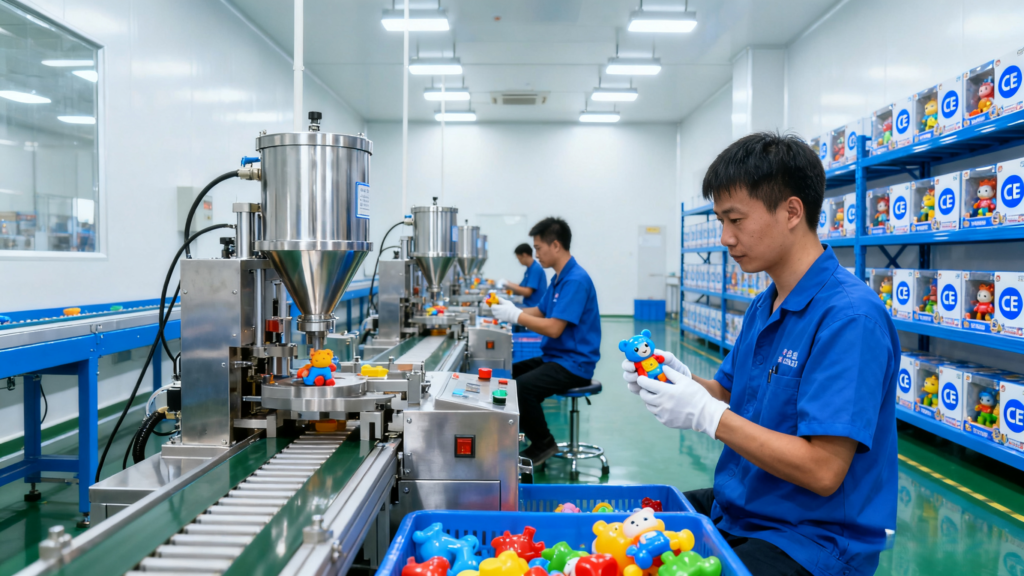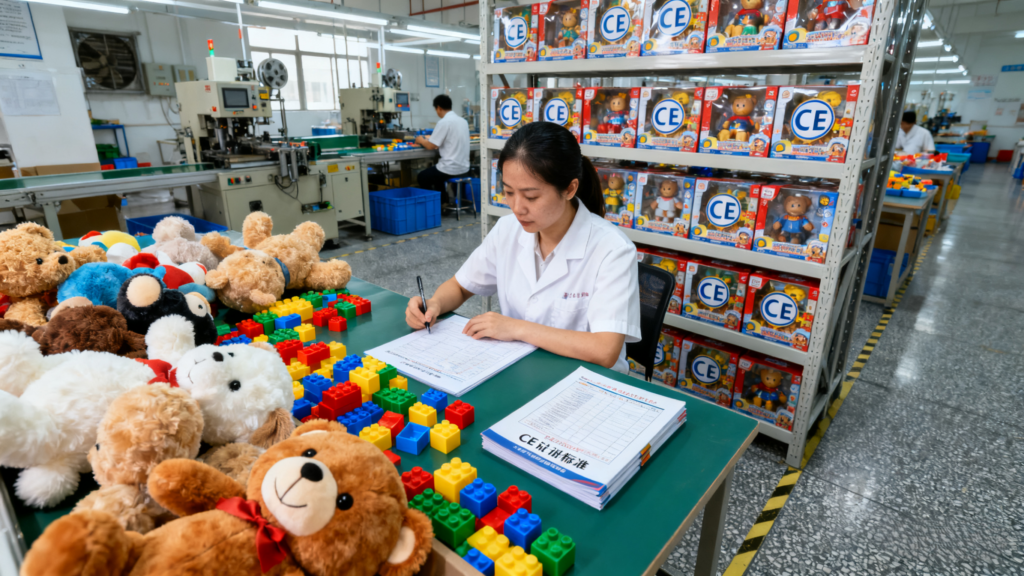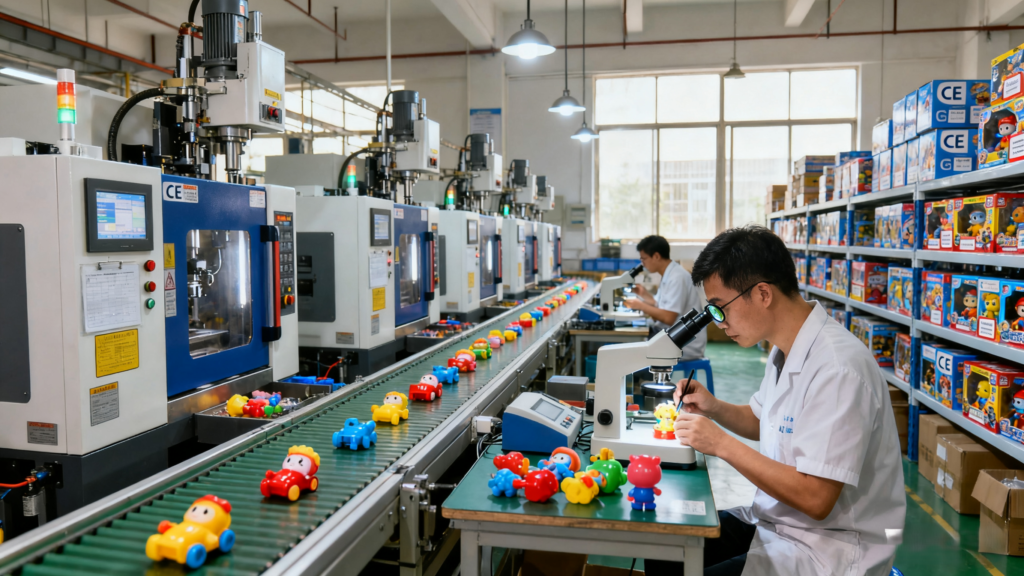The Ultimate Guide to China CE Certified Toy Factories: Definition, Types, Hubs & Top Manufacturers
Meta Description: Navigating the world of toy manufacturing? Our in-depth guide explains everything about a China CE certified toy factory: what it means, the different types, key manufacturing hubs, and how to identify top manufacturers for safe, compliant toys.

Introduction: The Gold Standard in Toy Safety
Imagine a parent in Berlin, a retailer in Barcelona, or a child in Rome picking up a new toy. Their trust in its safety is not blind; it is verified by a small, but powerful, mark: CE. This Conformité Européenne mark is the passport for products entering the European Economic Area (EEA), a legal declaration that the toy meets the EU’s exceptionally stringent health, safety, and environmental protection standards.
For global brands and distributors, the journey to placing a CE-marked toy on European shelves almost invariably leads to one country: China, the world’s undisputed toy manufacturing capital. However, not all factories are created equal. The critical differentiator is a deep, institutionalized commitment to compliance. This guide is your comprehensive resource to understanding, finding, and partnering with a legitimate and capable China CE certified toy factory.
We will deconstruct what the certification truly entails, explore the different types of factories, map their geographical distribution across China’s industrial landscape, and introduce you to the key manufacturers that set the industry standard.
Part 1: Defining a China CE Certified Toy Factory – Beyond the Logo
At its most fundamental level, a China CE certified toy factory is a manufacturing facility in China that produces toys conforming to the essential requirements of the European Toy Safety Directive (2009/48/EC) and is legally authorized to affix the CE mark to its products.
However, this simple definition is a facade for a complex, rigorous, and continuous process. The certification is not a one-time award but a holistic system of design, production, testing, and documentation. It’s a culture of safety ingrained in the factory’s operations.
The Pillars of CE Certification for Toys
For a factory to be genuinely certified, it must systematically address the following pillars:
- The Toy Safety Directive (2009/48/EC): This is the cornerstone legislation. It outlines comprehensive safety requirements covering:
- Physical and Mechanical Properties: Ensuring structural integrity to prevent breakage into small parts, eliminating sharp edges, and addressing strangulation hazards from cords.
- Flammability: Regulating the flammability of materials to prevent rapid ignition and fire spread.
- Chemical Properties: Enforcing strict limits on the use of harmful substances. This includes 19 heavy metals with specific migration limits (e.g., lead, cadmium, mercury) and restrictions on substances like phthalates (softeners in plastics) and certain aromatic amines from dyes.
- Electrical Properties: For electric toys, compliance with the Low Voltage Directive is required to prevent risks of electric shock, overheating, or radiation.
- Hygiene and Radioactivity: Mandating cleanliness to prevent infection and ensuring materials are free from radioactive contamination.
- Harmonized Standards (EN 71 Series): The Directive is supported by detailed harmonized standards, primarily the EN 71 series. Adherence to these standards provides a “presumption of conformity” with the Directive.
- EN 71-1: Mechanical and physical properties.
- EN 71-2: Flammability.
- EN 71-3: Specification for migration of certain elements.
- EN 71-8: Activity toys (e.g., swings, slides).
- EN 71-12: N-Nitrosamines and N-Nitrosatable substances.
- EN 71-14: Trampolines for domestic use.
- EN 62115: For electric toys (a standard under the IECEE CB Scheme).
- The Technical Construction File (TCF): This is the heart of CE compliance. For every toy model, the factory must create and maintain a detailed TCF, which includes:
- A comprehensive description of the design and manufacturing process.
- A detailed safety assessment identifying potential hazards.
- A list of all applied safety standards.
- Test reports proving conformity (from in-house or third-party labs).
- Copies of the EC Declaration of Conformity.
- Details of the manufacturer and any storage facilities.
- Testing and Verification: Proof of compliance is achieved through rigorous testing. This can be done via two paths:
- Self-Verification (Internal Production Control): For many non-electric toys, the manufacturer can perform tests in-house if they possess an accredited laboratory with the correct equipment and qualified personnel. The data is then included in the TCF.
- Third-Party Assessment by a Notified Body: For toys in certain categories (e.g., electric toys, complex chemical toys), involvement of an EU-notified body is mandatory. These are independent organizations designated by an EU member state to assess product conformity. They provide critical test reports that form the core evidence for the TCF.
- The EC Declaration of Conformity (DoC): This is a legally binding document signed by the manufacturer (or their authorized representative in the EU) stating that the product complies with all applicable EU legislation. The DoC must accompany the toy and be available to market surveillance authorities upon request.
- Affixing the CE Mark: Only after all the above steps are complete can the CE mark be legally affixed. It must be visible, legible, indelible, and at least 5mm in height.
Therefore, a true China CE certified toy factory is an entity that embodies this entire ecosystem. It’s not just a building with machines; it’s an organization with a robust Quality Management System (often ISO 9001 certified), invested in advanced testing equipment, staffed by knowledgeable compliance officers, and operates with meticulous traceability from raw materials to finished goods.

Part 2: The Typology of China’s Toy Factories – Finding Your Perfect Partner
Understanding the different operational models of Chinese toy factories is crucial for selecting the right partner. Your choice depends on your needs: Do you have your own designs? Do you need a factory to create them for you? Are you looking for a niche specialist?
1. Original Equipment Manufacturer (OEM)
- What they are: The classic manufacturing partner. An OEM factory produces toys based entirely on the designs, technical specifications, and blueprints provided by you, the client. You own the intellectual property (IP) and the brand.
- Their CE Role: The OEM is responsible for executing the manufacturing process to ensure the final product meets the CE requirements you have specified. They manage the testing (in-house or external), compile the necessary documentation for the TCF, and provide you with the DoC. Their expertise lies in precision manufacturing, quality control, and supply chain management.
- Ideal for: Established brands with in-house design and engineering teams who need a reliable production arm.
2. Original Design Manufacturer (ODM)
- What they are: The innovation and design partners. An ODM factory designs and develops its own toy lines. You can browse their catalogs, select existing products, and typically customize them with your colors, logos, and packaging (private labeling).
- Their CE Role: The ODM takes full ownership of the entire CE compliance process. Their in-house R&D teams design products from the ground up to meet international safety standards. They handle all testing and documentation, providing a turnkey solution. This is a massive advantage for companies lacking design resources.
- Ideal for: Startups, distributors, and retailers who want to bring unique products to market quickly without the high cost and time of internal development.
3. Private Label Manufacturer
- What they are: This is a service model rather than a distinct factory type. Both OEMs and ODMs offer private label services. It refers to the practice of placing your brand name on a product manufactured by them (either your design or theirs).
- Their CE Role: The factory guarantees that the product bearing your brand is fully CE compliant, following the processes of their primary business model (OEM or ODM).
- Ideal for: Anyone looking to build a brand without investing in manufacturing infrastructure.
4. Vertically Integrated Manufacturers
- What they are: The industry titans. These are often large, publicly traded corporations that control multiple stages of the supply chain. This can include raw material processing (e.g., operating their own plastic molding compounds plants), tooling and mold making, component manufacturing, final assembly, and packaging.
- Their CE Role: They represent the pinnacle of quality control. They often operate state-of-the-art, in-house laboratories that are accredited to international standards and may even be recognized as notified bodies. Their compliance is baked into every step of the process, offering the highest level of assurance.
- Ideal for: Major global brands requiring massive production volumes, utmost quality consistency, and full supply chain transparency.
5. Specialized Niche Manufacturers
- What they are: Factories that are masters of a specific material or toy category. They offer deep expertise rather than being generalists.
- Examples:
- Wooden Toy Factories: Often clustered in specific regions like Yunhe County, they are experts in wood processing, sourcing sustainable timber, and applying non-toxic, child-safe paints and finishes.
- Plastic Injection Molding Experts: Focus on complex mold design and high-volume production of plastic toys, from action figures to preschool learning toys.
- Die-Cast Metal Factories: Specialize in the hot metal molding process for creating detailed toy cars and models.
- Plush & Stuffed Toy Factories: Experts in textiles, sewing, and ensuring stuffing materials are hypoallergenic and hypoallergenic.
- Educational STEM Toy Factories: Focus on integrating electronics, coding, and mechanical components into safe, educational products.
- Their CE Role: Their deep focus means they possess unparalleled knowledge of the specific compliance challenges in their niche (e.g., EN 71-3 for migration limits in paints for wooden toys, flammability tests for plush fabrics).
- Ideal for: Brands looking for best-in-class manufacturing for a specific type of toy.
Part 3: The Geographical Distribution – China’s Toy Manufacturing Hubs
China’s toy manufacturing is not spread evenly across the country. It is concentrated in powerful industrial clusters, each with its own unique characteristics, specializations, and advantages.
1. The Pearl River Delta (Guangdong Province) – The Global Epicenter
- Key Cities: Shenzhen, Dongguan, Guangzhou, Shantou (Chenghai District), Foshan.
- Characteristics: This is the largest and most dominant toy manufacturing hub on the planet, leveraging its proximity to the financial and logistics gateway of Hong Kong.
- Shenzhen & Dongguan: The apex of high-quality, technologically advanced manufacturing. Home to the majority of vertically integrated giants and top-tier OEM/ODM factories. They excel in plastic injection molding, electronic toys, and sophisticated STEM products. Factories here are typically larger, more automated, and possess superior in-house R&D and testing capabilities. They are the partners of choice for the world’s most demanding brands. The emphasis is on quality and innovation over lowest cost.
- Shantou (Chenghai District): Rightfully nicknamed the “Toy Capital of China.” Chenghai is a mesmerizing ecosystem of thousands of small and medium-sized factories, overwhelmingly focused on plastic toys—especially toy cars, dolls, and puzzle games. It is a hub of incredible entrepreneurial energy, supply chain agility, and competitive pricing. While quality can vary, many factories are fully CE certified and excel at rapid, cost-effective production runs. Due diligence is paramount here.
2. The Yangtze River Delta (Zhejiang and Jiangsu Provinces) – The Specialist Hub
- Key Areas: Yunhe County (Zhejiang), Ningbo, Shanghai, Yangzhou.
- Characteristics: This region is known for its diversity and deep specialization in specific materials.
- Yunhe County, Zhejiang: The “Wooden Toy Town of China.” This single county is a global powerhouse for wooden toy production. The entire local economy is built around woodworking, with generations of expertise, specialized machinery, and a dense network of suppliers for timber, paints, and fittings. Larger factories in Yunhe are well-versed in CE compliance, particularly concerning EN 71-3 for chemical migration.
- Ningbo & Shanghai: Major international ports with excellent logistics infrastructure. Toy manufacturing here is often high-quality, serving as a strategic production base for companies wanting to leverage the world-class shipping facilities. The factories are a mix of large-scale operations and specialized manufacturers.
3. Other Emerging and Significant Regions
- Fujian Province: Has a strong and growing presence in the production of plastic and electronic toys.
- Shandong Province: An important manufacturing base with a mix of plastic, metal, and educational toy producers.
- Inland Provinces (e.g., Hunan, Sichuan): To benefit from lower labor costs and government incentives, some production has moved inland. However, these factories often still rely on components and materials sourced from the coastal clusters. The density of top-tier, well-equipped CE certified factories is currently lower than in the traditional hubs.
Choosing the Right Hub: Your choice involves a strategic trade-off:
- For High-Quality, Complex, & Innovative Toys: The Pearl River Delta (Shenzhen/Dongguan) is unmatched.
- For Wooden Toys: Yunhe County is the specialist leader.
- For Cost-Effective, High-Volume Plastic Toys: Chenghai offers immense options but requires thorough vetting.

Part 4: Main Manufacturers and Industry Leaders
While there are thousands of factories, several companies have established themselves as leaders through scale, quality, and reliability.
The Vertically Integrated Titans
- Hasbro China & Mattel China: While American brands, their massive owned and operated manufacturing facilities in China (primarily in Guangdong) are the gold standard. They represent the pinnacle of quality control, safety compliance, and ethical manufacturing processes. They are, by definition, among the most advanced CE certified facilities globally.
- Playmates Toys (Hong Kong, with factories in Guangdong): A giant known for iconic lines like Teenage Mutant Ninja Turtles. They are a fully integrated manufacturer with massive design, development, and production capabilities.
- Goldlok Holdings (Guangdong): A publicly-listed Chinese toy giant with extensive manufacturing parks. They offer full-service ODM/OEM production for major global brands across all categories, from plastic preschool toys to high-tech electronic products. Their in-house lab is top-tier.
Leading OEM/ODM Powerhouses
- Star-Moon (Dongguan): A renowned high-quality manufacturer often working with premium European brands. They specialize in plastic injection molding and electronic toys, known for their engineering excellence and robust compliance systems.
- Ming Tai (Dongguan): Another major player with strong R&D capabilities, producing a wide range of toys for the international market, including ride-ons, educational toys, and infant/preschool products.
Specialized Niche Leaders
- Factories in Yunhe County: Companies like Zhejiang Youyou Toy Products Co., Ltd. and Wooden Toys China are representatives of the high-quality wooden toy manufacturing the region is known for.
- Plush Toy Specialists: Factories in Yangzhou (Jiangsu) have built strong reputations for producing high-quality, certified plush toys.
Crucial Note on Verification: This list is illustrative. Always conduct due diligence. Verify certifications, audit reports (e.g., ISO 9001, BSCI, SMETA), and insist on third-party lab testing for your products, even if the factory has in-house capabilities.
Summary
Navigating the landscape of China CE certified toy factories requires a nuanced understanding.
- Definition: It’s a holistic system of compliance with the EU Toy Safety Directive, encompassing design, rigorous testing (to EN 71 standards), meticulous technical documentation, and the legal affixing of the CE mark.
- Types: Factories operate under different models: OEMs (build your design), ODMs (provide their own designs), Vertically Integrated giants (control the entire supply chain), and Specialized manufacturers (master a specific material like wood or plush).
- Geography: Manufacturing is clustered in key hubs: the high-quality Pearl River Delta (Shenzhen/Dongguan for tech, Chenghai for plastic volume), the specialized Yangtze River Delta (Yunhe for wooden toys), and other emerging regions.
- Manufacturers: The market includes global titans like Hasbro/Mattel, large Chinese publicly-listed firms like Goldlok, and countless proficient OEMs/ODMs like Star-Moon.
Selecting the right partner is a strategic decision balancing cost, quality, expertise, and reliability. Thorough due diligence, including factory audits and independent product testing, is non-negotiable to ensure a successful and compliant partnership.
Q&A: China CE Certified Toy Factory
Q1: Is CE certification for a toy from a Chinese factory the same as for a European factory?
A: Yes, absolutely. The CE mark is governed by European law, not by the country of manufacture. The exact same Directive (2009/48/EC) and harmonized standards (EN 71 series) apply to any toy sold in the EEA, regardless of where it is made. A legitimate China CE certified toy factory follows the identical process and bears the same legal responsibility as a European manufacturer.
Q2: Who is legally responsible for the CE mark – me (the importer) or the Chinese factory?
A: This is a critical point. Under EU law, both parties share legal responsibility. The Chinese manufacturer is responsible for designing and manufacturing a compliant product, carrying out the necessary conformity assessment, drawing up the technical documentation, and issuing the EU Declaration of Conformity. As the importer, you are responsible for ensuring that the manufacturer has correctly followed the process, that the documentation is available, and that the toy remains compliant when placed on the market. The importer’s name and address must also be on the product packaging.
Q3: What is the difference between a CE certificate and a test report?
A: This is a common area of confusion.
- A Test Report (e.g., an EN 71-1 report) is a document from a laboratory detailing the tests performed on a sample of the product and the results. It is evidence of compliance.
- A CE Certificate is often misunderstood. There is no single, official “CE Certificate” issued